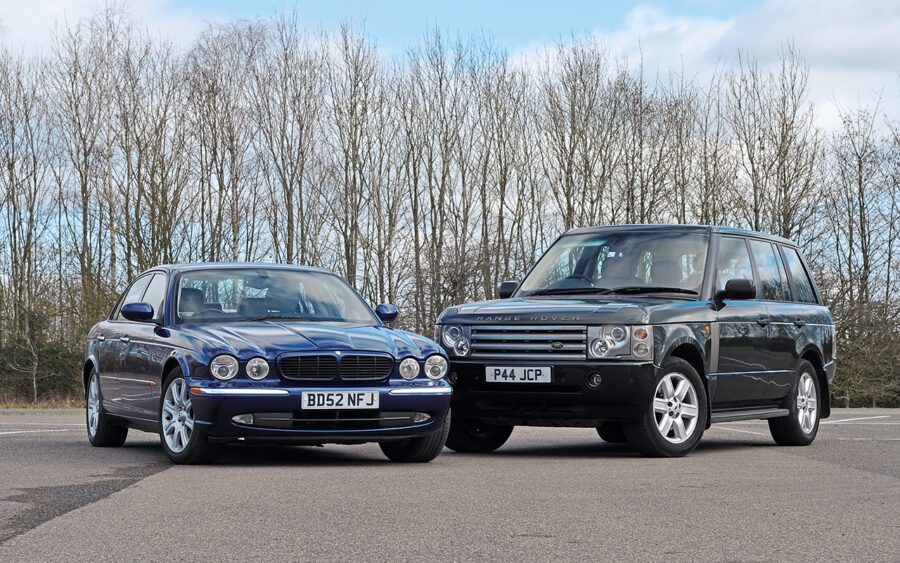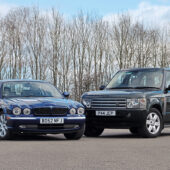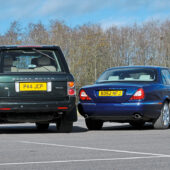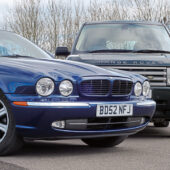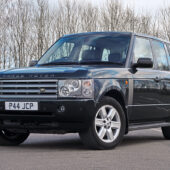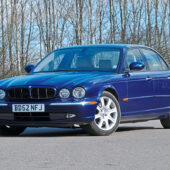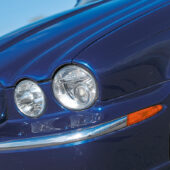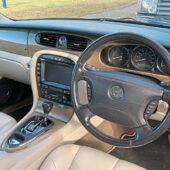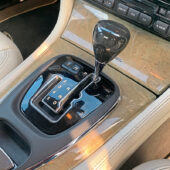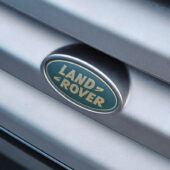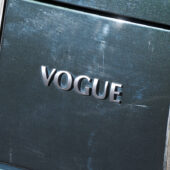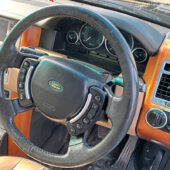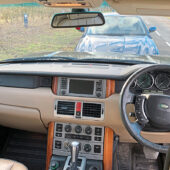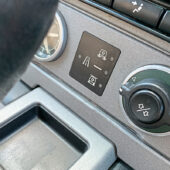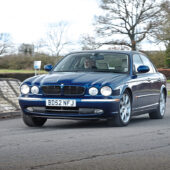Both the Jaguar XJ X350 and Range Rover L322 wowed the motoring press when launched as modern takes on traditional themes. But which is best?
Words Sam Skelton Images: Paul Wager
Jaguar and Land Rover may not always have been sister brands, but the buyers of one have long had the other on their shopping list. The X300 and the second-generation ‘P38a’ Range Rover were launched on consecutive days in 1994, marking the true turning point where the brands were considered in the same breath – and many magazines pitted them against each other in period.
But perhaps a more interesting test would be to compare their replacements – for it was during the lifetime of both the X350 and third-generation ‘L322’ Range Rover that Jaguar and Land Rover became bedfellows, and it was in the L322 that Jaguar technology would first be felt as part of a mid-term facelift. Both cars evolved the themes of what came before to appeal to audiences in the new millennium, and by this point the Range Rover was tending more toward the luxury car than the tractors of old.
Land Rover’s then parent BMW began development work on the L322 almost as soon as the P38a was launched in 1994 since it felt that the older design was dating fast and would need replacing sooner rather than later. The new car would deviate from tradition in that it would employ monocoque construction in place of a separate chassis, though it would build upon its predecessor’s use of air suspension.
The L322 would also build upon the P38’s choice of a BMW diesel engine, borrowing both diesel and petrol options from the contemporary 530d and 540i. Larger than its predecessor – 38mm longer, 33mm wider and 43mm taller – the differences in size would feel even greater from within. New for Range Rover would be the Hill Descent Control system introduced on Discovery 2 and Freelander, allowing automatic braking for descents . The H-pattern dual gear selector was gone too, in favour of a low-range switch and Steptronic control. Cars equipped with satellite navigation could also guide you off road, and in the finest Vogue-spec models there was even a television tuner unit.
Styling work was essentially completed by 1998 but the sale of Land Rover to Ford meant internal politics would affect development, with the V12 proposal abandoned and the more powerful 3.0 diesel from the X5 denied to the Range Rover. Even before the launch there was an agreement that technology would be replaced with Ford componentry in due course, which would happen with the 2005 facelift.
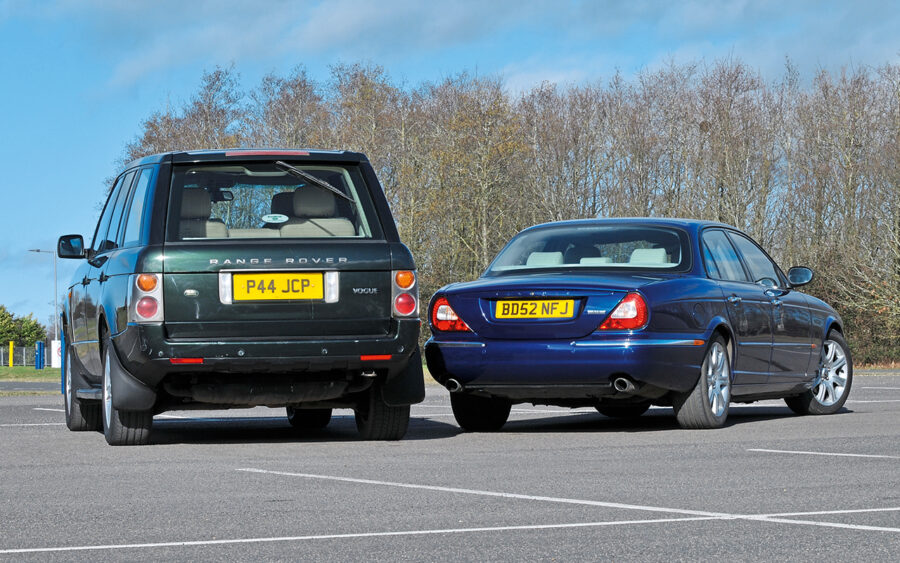
The launch was intended for the Earl’s Court Motor Show in 2001, but this event was cancelled just three months beforehand, leaving Land Rover no international event at which to launch. Media information would thus trickle out from September to December 2001, and the first cars were delivered in February 2002. By 2005, the BMW V8 had been replaced by Jaguar’s AJ-V8, while a V8 diesel related to the X350’s V6 would be fitted from 2007. The Range Rover L322 would survive with further detail improvements until 2012, when it would be replaced by the L405 model.
The X350 represented a whole new way of thinking for Jaguar, though from outside, it looked to be a case of ‘business as usual’. Weighing in 40% lighter but 60% stiffer than the outgoing X308, the shell was created from aluminium and used a mixture of adhesive bonding and riveted joints.
This technology, borrowed from the aerospace industry, was chosen as it was light and stiff – and it was a first in the automotive sector. The front and rear subframes were made of steel, while the seat frames and other elements of trim were made of magnesium to reduce weight further still.
The X350 not only drew on older Jaguar designs such as the original XJ by returning the XJ to a four-lamp face but adapted modern bold styling concepts to integrate with the traditional themes. Inside, it was much of the same with Giles Taylor reworking the traditional wood and leather into a style that appeared classical yet contemporary.
A central touch screen dominated the dash of higher-end models, offering control to the heater, radio and other minor ancillaries. Jaguar embraced air springs with the new car, pairing them to the Computer Active Technology System to offer a good ride with no compromise to handling. The system would activate every 24 hours to level the car, even if not in use.
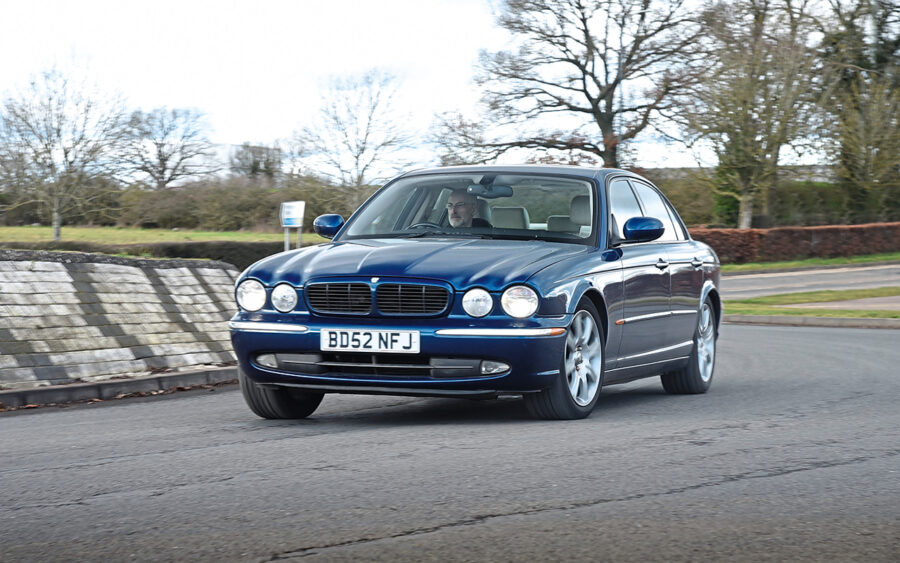
Jaguar unveiled the car at the 2002 Paris Motor Show, with a highly polished aluminium example the centre of the display at launch. It would be produced until 2007, replaced by the facelifted X358 model.
This brings us to the choice you see before you and while it might have been more balanced to look at a Jaguar-engined L322, we think that the earliest examples of both are where the interest lies and where we might see the most diverse results. That’s why we’ve brought together our own 2003 XJ8 4.2 Sport with a 2002 Range Rover 4.4 Vogue – the earliest example, with much of its technology and powertrain lifted from the BMW 540i. Which makes the better all-round classic buy today?
Both cars used styling well, inside and out, to create a definitive image separate to the corporate ladder of the German alternatives. Bolder designs were coming to the foreground in the early 2000s, and these cars both took advantage of that to reimagine old concepts.
The modern yet retro look of the X350 XJ was arguably Jaguar’s best piece of design from 1998 to 2003 – not as painfully old-aged as the S-Type and X-Type, but with just enough touches from history to be recognisable as an XJ. With a higher roof line than the outgoing car as a result of Ford managers insisting on extra headroom, there’s more than a hint of the earliest XJs about the overall profile despite the extra length.
While SE and Sovereign models had lashings of chrome, Sport models were largely dechromed and in all cases the look was more reserved than the outgoing X308 model, despite the technological advances under the skin. The Pacific Blue paintwork suits the Sport model in particular – subtle, with just a hint of raciness.
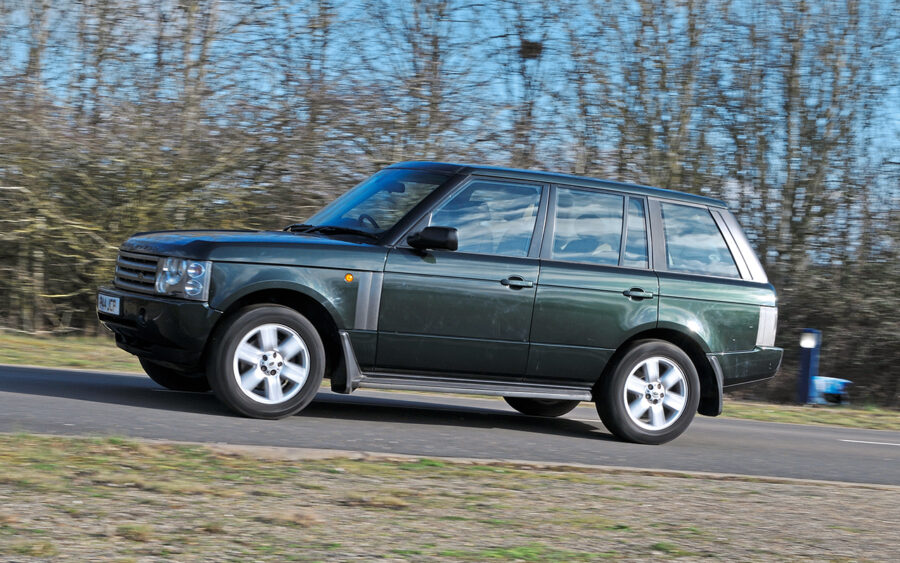
In comparison, it doesn’t get much more Establishment than an Epsom Green Range Rover. And where some of the detailing perhaps looked heavy-handed in 2002, things like the headlamps and the gills now look subtle in comparison to modern Range Rovers. As a piece of modern design it works, while there are just enough retro calls to appeal to the traditionalist. It’s certainly one of the most compelling shapes of its era and one that’s becoming ever harder to appreciate in a world where so many sport naff bodykits, tints and large wheels losing the delicacy of the original.
Inside, the two cars both meld the traditional with the modern. Jaguar’s way of doing this with the XJ8 Sport was to use high-contrast interior trimmings to appeal to more youthful markets, and the Warm Charcoal and Ivory interior in our 4.2 fits that theme perfectly. Black carpets, door inserts and dashboard top might clash with the Ivory door cards and seats, but overall there’s a clean and modern feel to the X350 rather than an excess of tradition.
The touch screen is nicely integrated and fairly intuitive, and you don’t feel lost for the lack of buttons. The bird’s eye maple, almost grey, fits with the high contrast black and white feel, making the seats feel whiter than they really are. And while it’s bigger in here than in older XJs, it still feels snug like Jags of old, with nice figure-hugging armchairs and a tall centre console.
Though arguably not quite as special as the Range Rover. Journalists at the time were wowed by the interior, and the way its colour combinations played with the overall shape. Instead of using a traditional appearance and youthful finishes, Land Rover used traditional finishes in a modern manner. The slabs of wood look structural, while there are shiny metallic finishes too to contrast with the traditional hides. There is a television – which had the potential to appear naff, yet works because of the melding of old and new.
It feels big – far bigger than the Jaguar, and the space can seem daunting at first. Again, the appeal of this interior is one I have forgotten, where most L322s we see have black leather and wrapped finished over the wood trim. This car isn’t about the modern concept of luxury. It’s about the application of modern techniques to the traditional concept and as a result, it really works. This car is fitted with the optional Communication Pack, adding some £1150 to the original £59,995 list price and incorporating a telephone and voice activation. And while for an XJ the X350 has a surprisingly big boot, it can’t hold a candle to the cavernous cargo bay of the Range Rover.
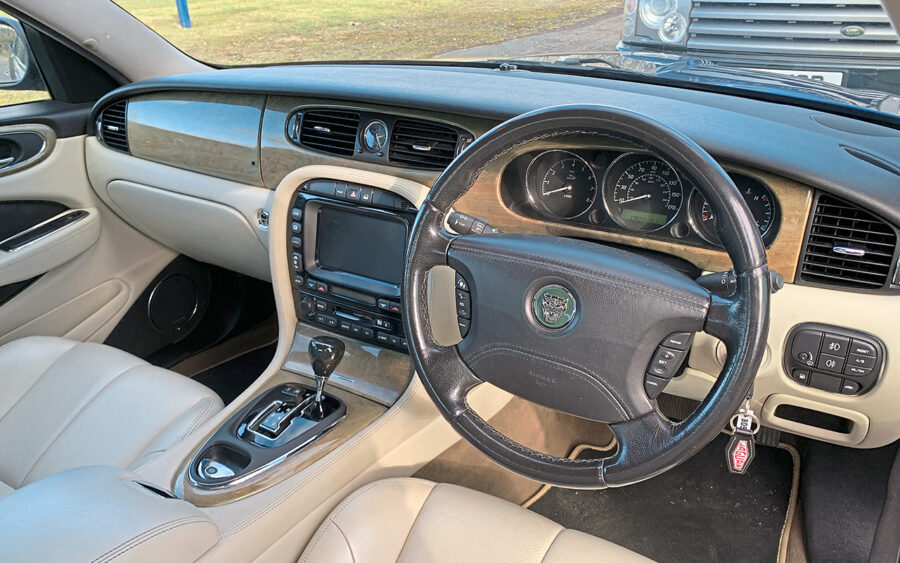
Everything about the Jag feels light at first – the oddly airy cabin, the light doors, and the speed with which it picks up pace. Unsurprisingly, with similar power outputs and far less weight the Jaguar is a far more potent performer than the Range Rover – and while the air suspension makes it firmer than older models, it’s still perfectly comfortable once you settle down into top gear for a cruise. The seats are good, the Alpine stereo is great, there’s actually space for four adults in an XJ for once and a useful boot.
But if you want to have fun, it almost shrinks around you, feeling more the size of the S-Type than a supertanker. The controls have just enough weight to feel engaging, and the power’s right there when you want it. You can throw it around, have some fun with it – which isn’t something that can be said for most of its rivals.
And certainly not the Range Rover L322, which is carrying almost an extra ton of weight, to say nothing of trying to propel a second driveshaft and axle and sitting several inches higher. Throwing this around is not a job for the faint hearted, and it would far rather you sit back and enjoy the cruise. That’s not to say it’s a slug, though – a 9.0-second 0-60mph time might not be impressive, but remember the weight of this car and the fact it will outpace a mid-range Mondeo suddenly doesn’t seem disappointing.
The practicality of five seats and space for a wardrobe puts it ahead from a common sense perspective; it feels imposing, comfortable, and serene, and you feel far more isolated in here than you do in the Jaguar – but it comes at a cost. Stick to motorways and town centres and the Range Rover L322 will do everything the Jag will do – but on your favourite B-road with nothing in front of you, you’ll feel like you’ve brought the wrong car. Amusingly though, the gearbox has a Steptronic ‘manual’ control mode.
Of the two, the Range Rover makes the driver feel more special. But the Jaguar is a far more special car to drive.
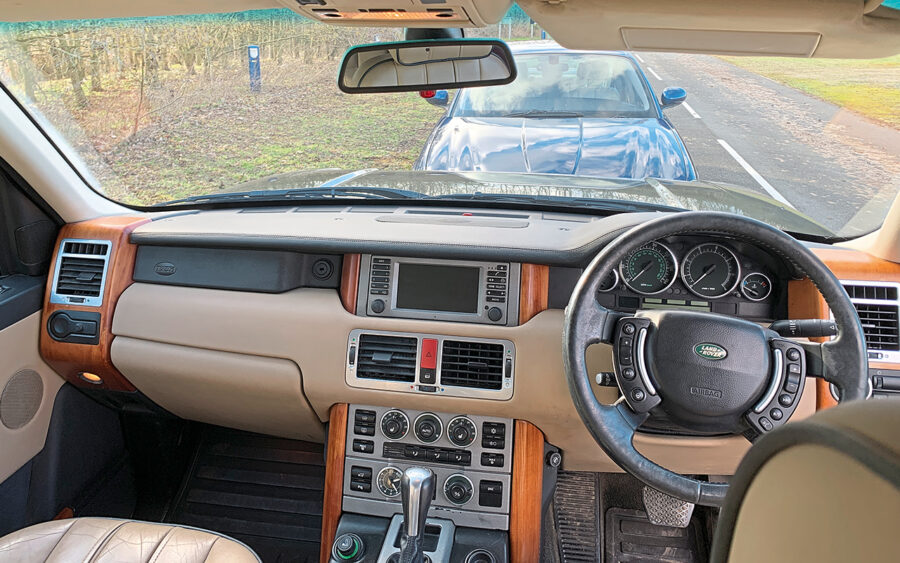
Jaguar XJ8 (X350) vs Range Rover (L322): our verdict
So which one of these two cars would I be taking home in an ideal world? If I wanted the ultimate symbol of British craftsmanship from the early 2000s – something that would have wowed the neighbours when new, something that was up to the minute yet traditional, and something that stands up well today – would it be the car from Solihull or Coventry?
Well, it’s time for a confession. The L322 Range Rover Vogue in the photographs belongs to me. I’ve just bought it after a six-month search for the right example, I use it every day, and I couldn’t be happier with the car.
I tested this very Jaguar against another BMW-powered saloon a year ago, and at the time I said that the E65 7 Series felt like a tool while the Jaguar felt far more personal. The thing is, the Range Rover manages to feel even more so – it melds genuine go-anywhere and carry-everything capability with the feeling that the only way up from here is a Rolls-Royce – by this time, another British institution controlled by German money.
It gets right everything BMW’s own XJ rival got wrong, and in the process manages to take the top spot here. By contrast, I don’t think the X350 is necessarily an improvement on the car that went before – if I want to drive an XJ, I’ll get into my old X300.
So it’s a win for the Range Rover. That’s not to say the Jaguar X350 is a bad car – and especially not in its 20th anniversary year. But as an overall package, the Solihull stormer just has the edge.

